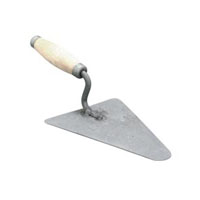 In this article we want to talk about such a construction tool as a trowel. For most people, this tool is better known as a construction trowel or just a trowel. That's what most builders call it.
In this article we want to talk about such a construction tool as a trowel. For most people, this tool is better known as a construction trowel or just a trowel. That's what most builders call it.
It is impossible to say exactly why this name appeared, but most likely due to the fact that this is the main tool of a bricklayer, which, in order for the masonry to turn out beautiful, must have a significant level of skill, hence the name.
In the general concept, a trowel is a piece of sheet metal mounted on a wooden or plastic handle. At the same time, the plane of the metal does not coincide with the plane of the handle, which makes it possible to both conveniently hook the finishing material and apply it to the desired surface. The distance between the planes of the metal part and the handle is usually from 3 cm to 5 cm.
If we describe in general the principle of operation with a trowel, then it is as follows: the worker hooks the necessary portion of building material from the tank with a metal plane and throws it onto the surface to be finished. After that, by pressing and smoothing the building material with a trowel, it is given the necessary thickness.
The metal part is made of sheet steel with a thickness of about 1 mm. In this case, the petal itself (flat part) is made in various forms. So it can be in the form of a drop, a rectangle or a trapezoid. The variety of forms is due to the purpose of the trowel. Depending on the type of work for which the trowel is intended, the corresponding type and size of this tool is more convenient.
Trowel types
1. Trowel for concrete and stone work
This type of trowel (trowel) is used to level the surface of poured concrete or masonry mortar in the process of laying walls from bricks or wall blocks, as well as trimming excess mortar that protrudes between bricks or blocks. Of the features of this trowel, the triangular shape of the metal flat part with rounded edges can be noted. The wooden handle of the trowel at the end has a special metal cap. It is necessary in order to protect the handle from cracking, since it is with the handle that the bricks are knocked out, aligning them with the level of the row. True, you can find models with a completely plastic handle or with a wooden one without a protective cap.
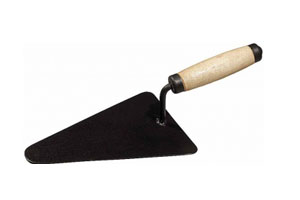
2. Trowel for furnace and stone work
The scope of this trowel is the laying of stove and ventilation ducts made of stone materials. In appearance, it is very similar to the previous view, except that the back face of the metal plane has a rounded shape. The trowel handle is also protected by a metal cap. The plane of the trowel is relatively small in size, since during furnace work it becomes necessary to clean the solution in hard-to-reach places (corners, turns) and a small tool is required here.
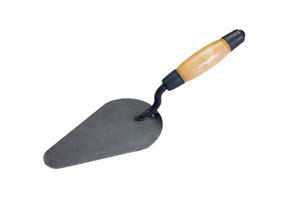
3. Trowel for plastering
This trowel is intended for work by plasterers and finishers. Due to the greater width (compared to previous types) with this trowel it is convenient to throw plaster solutions on the surface, as well as their leveling. The large plane prevents the plaster mortar from running off the trowel, which is inferior in viscosity to concrete or masonry mortar. The shape of the metal part of this type of trowel resembles a heart.
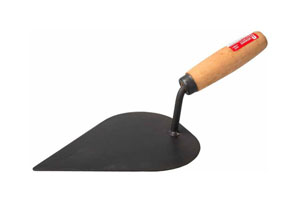
4. Trowel for finishing work
This trowel is used as a plastering tool and for some auxiliary operations that cannot be done with other trowels. The fact is that this trowel has the shape of a narrow trapezoid and, for example, the remains of a solution from a bucket can only be selected with its help. It will also be very useful for a mason, for example, in hard-to-reach places of complex protruding masonry.
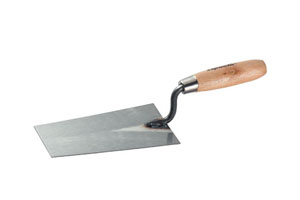
5. Trowel for tile work
In appearance, it looks like a stonemason's trowel - the same triangular shape, but the corners of the flat part are not smoothed, but, as it were, cut off. This design is more convenient for trimming adhesive or mortar applied to tiles and wall surfaces.
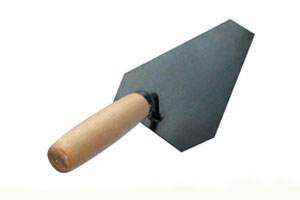
Of course, we have not described all types of trowels. In terms of form and functionality, you can find many more types in stores, although they in one form or another resemble the already described types. Some are more convenient, others less - it depends a lot on what material is used for construction, the shape of the building structures being erected, as well as the viscosity of the applied solution.
You can also find special trowels for applying adhesives, fillers, etc. Separately, we note trowels for forming corners. The flat part of these trowels is a rectangular plate bent at a right angle. The bend is made depending on which corner the trowel is made for (internal or external).
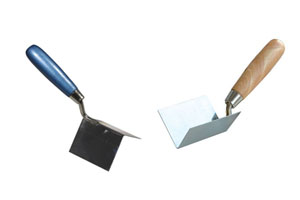
Other hand painting tools
|
Useful articles |